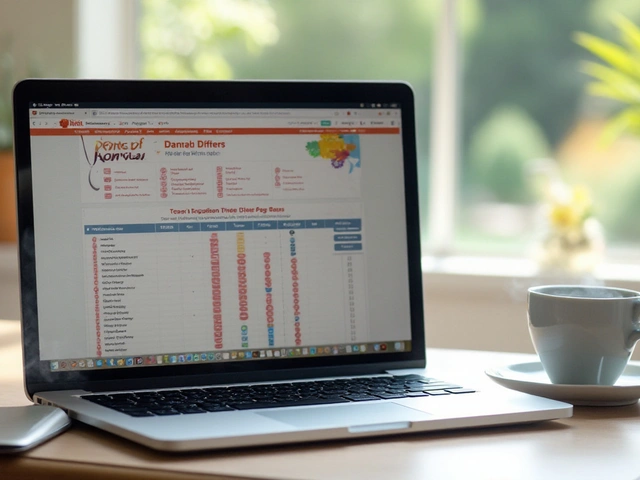The luteal phase sounds technical, but its drama plays out in almost every pregnancy story—sometimes as the unseen villain. Imagine—everything goes right: ovulation happens, sperm meets egg, but then, the signal fizzles where the corpus luteum should shine. Welcome to the rabbit hole of luteal phase defect (LPD), the quiet roadblock tripping up so many who never see it coming. Turns out, the tiniest shifts in hormonal balance during the days after ovulation can decide if your pregnancy gets the green light or not. Ignore it, and it's nearly impossible to fix something you can’t spot. Let’s pry open the science and stories around inadequate corpus luteum and its heavyweight role in pregnancy.
How the Luteal Phase Dictates Implantation: The Science Behind the Trouble
The luteal phase is the window after ovulation, defined by what the leftover follicle (the corpus luteum) does while waiting for a fertilized egg to settle in. Think of the corpus luteum as the caretaker of your uterus, producing just enough progesterone to keep the endometrium plush and welcoming. But when that care drops off—whether it’s just a couple days too short, or hormone levels fade too soon—you’re left with a luteal phase defect.
What does that really do? Progesterone’s job is to switch your uterine lining from its growth phase (under the influence of estrogen) to a secretory phase. This secretory phase is all about prepping the lining for a possible embryo—making it spongy, packed with nutrients, and ready to entertain a clingy blastocyst. Without reliable progesterone, the lining can’t mature right. Instead, it might shed early, or just not develop properly, leading to repeated implantation failure.
Here’s something that’s pretty wild: Many people never know their luteal phase is off. Tracking periods sounds straightforward, but sometimes LPD only shortens the luteal phase by a day or two—barely noticeable without detailed tracking. On average, the luteal phase lasts 12 to 14 days. Anything less than 10 days is suspicious. But it’s not just timing—your progesterone levels in the mid-luteal phase (about 7 days after ovulation) tell the full story. If they consistently dip below 10 ng/mL, your corpus luteum isn’t pulling its weight. And there’s more: even with textbook timing, some people’s uterine linings don’t respond to progesterone right. It’s a hormone game, but the receptors can lose, too.
Let’s get nerdy for a second and walk through the hormonal relay. At ovulation, that follicle now emptied of its egg transforms almost overnight into the corpus luteum. The brain’s luteinizing hormone (LH) surge coaxes this transformation, and for the corpus luteum, it’s go-time: crank out progesterone, keep estradiol humming, and hope for HCG from a fertilized egg. If that egg implants and churns out HCG, the corpus luteum gets a reprieve, remaining at work until the 10th week or so of pregnancy. Skip the HCG signal, and the corpus luteum collapses. But in LPD, this collapse—or underperformance—happens even when there’s a fertilized egg waiting for a home.
The reasons for corpus luteum burnout are all over—sometimes it’s low LH surges, other times stress, weight changes, thyroid issues, or over-exercising. Some women are clear-cut cases (like with PCOS or after fertility treatments that mess with hormones), while others just slowly notice that positive tests never stick, or periods sneak up too quickly.
Research backs up just how big an obstacle LPD is. Studies show LPD occurs in 3% to 10% of women with normal cycles, but it jumps up to 20% to 30% in those with unexplained infertility or recurrent pregnancy loss. That’s not rare—and even more worrying, standard fertility workups sometimes skip over luteal phase assessment entirely.
So, if you’re tracking, check if your luteal phase is always less than 11 days, or if spotting starts early and often. Progesterone lab draws around 7 days after ovulation offer another clue. And here’s the kicker: not all ovulation predictor kits or apps are sensitive enough. You might think you’re ovulating when you’re not producing strong LH surges, or your body isn’t turning those signals into robust progesterone. If you’re wondering whether you can get pregnant even if you’re not ovulating, it’s worth digging into resources like can i get pregnant if I don’t ovulate.

Signs, Symptoms, and Consequences: Here’s What to Look Out For
So how do you actually know if luteal phase defect is your hurdle? What does your body tell you? First, the frustrating part: most symptoms are subtle enough that people brush them off for years. But once you know what to look for, patterns start appearing. Classic signs include a luteal phase shorter than 10 days, early spotting before your period, or periods that seem to arrive before they’re due. For some, it’s a string of early positive pregnancy tests that fade into a period, signaling implantation may have briefly happened but never stuck.
Your menstrual tracking app isn’t always enough. Basal body temperature charts can help—normally, progesterone causes a noticeable temperature jump after ovulation, and if this high phase is shorter than 10 days, that’s a red flag. But, temperature tracking isn’t perfect; illness, insomnia, alcohol, or travel can all throw off your numbers. Still, if you’re seeing early dips, repeated brief luteal phases, or premenstrual spotting, take it seriously, especially if you’re struggling to conceive.
Aside from the logistics, the emotional toll can be huge. Many who deal with LPD feel like they’re stuck on a fertility rollercoaster—brief hope, early losses, then starting the cycle all over again. It’s not just about missed periods; it’s the sense that your body is missing a memo nobody else seems to care about. And while LPD often flies under the radar at the doctor’s office, it’s worth insisting on deeper investigation if your gut says something’s off.
Medical testing focuses on two main things: checking for progesterone production and looking directly at the uterine lining. The midpoint of your luteal phase (usually 7 days after a positive ovulation test) is when you’d get bloodwork for progesterone—levels should land around 10-20 ng/mL. Lower than that means your corpus luteum isn’t keeping up. In rare cases, a doctor might do an endometrial biopsy to see if your lining is properly matured by progesterone, but this is less common now that better hormone tracking exists.
It’s easy to confuse LPD with other fertility problems like PCOS or thyroid disorders, since both can mess with cycle length and hormone signals. The difference is, even if you ovulate, LPD is about what happens after—the post-game rituals of your hormones, not just the play itself.
Here’s something that trips up a lot of people: you can have a perfect ovulation and still not get pregnant month after month, just because your uterine lining wasn’t properly prepped to hold onto a fertilized egg. Or, you get those super faint lines on a test, only to have them disappear in a couple days, which often means implantation tried but failed because of hormonal shortcomings. Besides standard period symptoms—cramps, mood shifts, breast tenderness—LPD doesn’t usually come with any extras, so it’s easy for doctors and patients alike to miss it.
It’s not just about conception either. Women with LPD can be at greater risk for early miscarriage because the endometrium is less stable. In fact, research suggests that correcting LPD can lead to both higher pregnancy rates and lower miscarriage risks in women who have struggled with multiple failed cycles.
Practical tips? Start by charting your own data: use ovulation kits, temperature charts, and period logs for a few months. If you spot short luteal phases or habitual spotting, ask for hormone testing. Don’t be shy about requesting repeated tests if you suspect pattern issues—progesterone fluctuates wildly in one cycle. And while some clinics may be quick to suggest higher-tech solutions, many LPD cases respond well to simple interventions.

Treatment Options, Personal Strategies, and What Actually Works
The good news is, luteal phase defect doesn’t always need high-tech fixes. Sometimes simple changes can give your corpus luteum the boost it needs. For starters, stress really does matter—cortisol and related hormones can shut down the signals needed for strong LH surges, which means less progesterone. If your cycle shortens during a tough month, stress management can sometimes restore balance. Getting enough healthy fats and protein helps, because hormones are built from cholesterol and amino acids.
Women who over-exercise or have very low body fat often see their luteal phase shrink, too. A little weight gain (or taking rest days from intense workouts) sometimes lengthens cycles by restoring normal hormone function. On the other hand, PCOS and thyroid conditions often come with both ovulatory and luteal-phase problems. Managing those underlying issues, with medication or lifestyle changes, can shore up the luteal phase as well.
Medical treatment for LPD usually focuses on progesterone supplementation. This can be as simple as a vaginal or oral progesterone pill taken in the second half of your cycle. Clinical studies show this kind of support improves pregnancy outcomes in women with recurrent pregnancy loss or short luteal phases. In certain cases, doctors might offer ovulation induction medication (like Clomid or letrozole) to strengthen ovulation signals and help the corpus luteum form more robustly. But, more intervention isn’t always better—if the problem is just a mild dip in progesterone after ovulation, targeted progesterone is often the best answer.
One major debate in fertility clinics is whether LPD should always be treated if found, because some experts argue short luteal phases don’t always cause implantation failure. But, personal experience and research suggest that if you meet the classic patterns—early spotting, short high temperature phase on charts, low mid-luteal progesterone—support is worth trying, because it’s safe, side effect–light, and may give you that much-needed window for an embryo to settle in.
Supplements can sometimes help. Vitamin B6, for example, has been linked in studies to longer luteal phases and more stable hormone levels—worth considering if you want a non-medical solution. And while there’s not a miracle cure, some women swear that acupuncture or herbal remedies like vitex agnus-castus (chaste tree berry) helped regularize their cycle. The science is mixed, but if you’re interested in holistic support, just make sure your provider knows what you’re using.
The fertility journey is full of "try this" advice, but don’t settle for guesswork if you suspect LPD is blocking your path. Document your cycles with as much detail as possible, ask for specific hormone tests, and advocate for real answers—not just band-aid solutions. Your intuition and body’s subtle signals are powerful; listen to them, take notes, and push for personalized solutions. And don’t underestimate emotional support or peer groups; sometimes, hearing other stories reveals patterns that doctors haven’t spotted yet.
If nothing is working or you have added challenges (like repeated failed IVF with good embryos, or a history of miscarriage), see a reproductive endocrinologist—these specialists know how to dig into complex hormone puzzles. It’s not just about getting treatment; it’s about understanding the story your hormones are trying to tell, month after month.
The bottom line? Luteal phase defect isn’t the headline topic, but for countless people struggling with repeated disappointment, it’s the hidden culprit with a surprisingly simple fix. Don’t let it sit in the shadows—shine a light on your data, demand clear answers, and stack the odds for implantation in your favor. Sometimes the smallest tweak in the second half of your cycle makes all the difference between heartbreak and a positive test that finally sticks.






William Mack
17 July, 2025 . 23:03 PM
This article is a solid introduction to a topic that often flies under the radar in fertility discussions. The luteal phase defect is something many people don't realize can seriously disrupt implantation.
I've seen friends struggle with unexplained infertility and reading technical explanations like the role of the corpus luteum really helps put things in perspective.
Knowing the hormonal cues that the body gives can empower people to seek appropriate treatments instead of feeling lost in the process.
I wonder what the latest advances are in detecting these defects early on and how accessible those tests are in different healthcare systems across the US.
Thanks for breaking down complex science into something more approachable.
Evan Riley
21 July, 2025 . 03:33 AM
Honestly, I’m suspicious about how much the medical industry highlights or overlooks conditions like luteal phase defects.
Could there be underdiagnosis on purpose because fertility treatments are so profitable? Makes you think.
Most times I see treatments pushed without full disclosure of what’s really going on hormonally.
This article is good but I'd like to see some real-world data or testimonies from people who got misled by doctors.
Are these defects easy to fix or just another way to keep people chasing expensive procedures?
Nicole Povelikin
21 July, 2025 . 13:00 PM
I gotta say, some of this sounds like total guesswork. Like how do we REALLY know if the luteal phase is defective or if it’s just some other fertility thing?
Honestly, I’ve read endless horror stories about people getting blamed for 'defects' that don’t exist or are overdiagnosed to milk money.
This article ignores the emotional toll that comes with fertility struggles and just focuses on the science, which is not comforting at all.
Plus, how much can you trust 'evidence-based' guides when science itself changes its mind all the time?
Michelle Weaver
21 July, 2025 . 22:20 PM
Thank you all for your thoughts on this very sensitive topic ❤️
As someone who works with patients facing fertility challenges, understanding luteal phase defect is crucial to individualizing treatment.
The corpus luteum’s hormonal role cannot be overstated—it truly is a cornerstone for implantation success.
While treatments vary, progesterone support has shown considerable promise in recent clinical studies. 🌺
For anyone curious, monitoring basal body temps and hormonal levels during the luteal window can provide invaluable insight.
Keep asking your providers questions and advocating for yourself or your partner—knowledge is empowering! 🌟
John Keough
23 July, 2025 . 10:26 AM
Great post! The physiological aspect of implantation is often a mystery to many.
It’s fascinating how a seemingly small glitch in the luteal phase can have such a big impact on conception odds.
I’m curious if there’s emerging research exploring lifestyle factors that might improve corpus luteum function naturally? For example, nutrition or stress reduction.
It’d be awesome if more holistic approaches were combined with medical treatments.
Anyone here have experience with that?
Graham Smith
25 July, 2025 . 18:00 PM
This article is well-written but could use some proofreading and tightening.
The phrase ‘an inadequate corpus luteum disrupts the hormonal support’ could be more precise, perhaps ‘impaired corpus luteum function reduces progesterone production essential for implantation.’
Accuracy in description helps both lay readers and medical professionals.
I appreciate the inclusion of both symptoms and scientific background, though more citations would improve credibility.
An unpolished piece, but valuable nonetheless.
Jeremiah Morgan
28 July, 2025 . 21:06 PM
I find this topic to be both hopeful and challenging.
Understanding luteal phase defect turns months of frustration into actionable steps toward pregnancy.
However, the emotional rollercoaster that comes with testing and treatment is often underrepresented in these discussions.
Encouragement and empathy from healthcare providers are paramount alongside scientific clarity.
Grateful for resources like this that inform without overwhelming.
nina greer
1 August, 2025 . 00:06 AM
Honestly, I find the popularity of terms like 'luteal phase defect' somewhat tiresome.
It tends to be a catch-all label in the fertility world when no one is really sure of a diagnosis.
Concise scientific communication is required, not jargon that confuses hopeful couples further.
This article tries but doesn’t quite nail the precision I’d expect for something so important.
Montague Tilmen
4 August, 2025 . 03:06 AM
Look, at the end of the day, nature knows best and over-medicalizing reproduction is a mistake.
People should stop obsessing over every little defect and trust their bodies more.
Stop the pharmaceutical agenda pushing costly interventions and let conception happen naturally.
We need to value common sense above all else.
Clarise Wheller
7 August, 2025 . 06:06 AM
I appreciate the mix of science and real stories here.
Often fertility discussions get lost in dense medical language and miss the human element.
This article manages to provide both information and empathy.
Does anyone here have advice on how to approach your doctor if you suspect a luteal phase issue?
Sometimes it’s hard to know what questions to even ask.
Riley Fox
10 August, 2025 . 09:06 AM
Ah, the luteal phase defect conundrum: overhyped or genuinely pivotal for implantation?
The language used in the article is somewhat florid and borderline pretentious, if I might add. 😏
Still, the physiological basis does stand, and progesterone's role is undeniable.
I'm surprised more attention isn’t paid to the philosophical implications of blaming a ‘defect’ within a natural process.
Embrace the mystery of life, but with a dash of rigorous science, please. 🤓